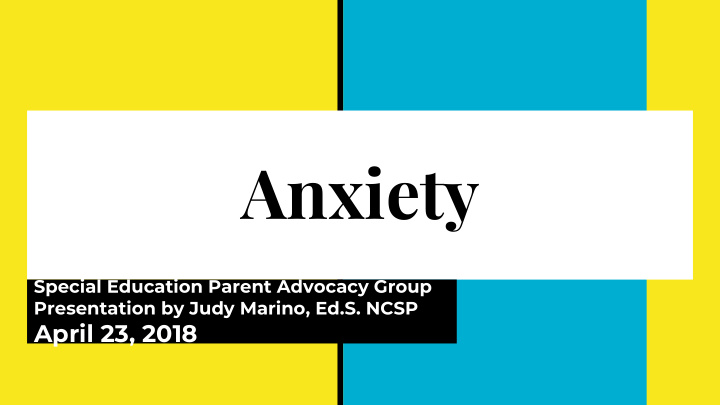



Anxiety Special Education Parent Advocacy Group Presentation by Judy Marino, Ed.S. NCSP April 23, 2018
What is Anxiety? “Fight or flight response” - How do you feel when you are anxious? Occasional anxiety is a normal part of life. You might feel anxious ● when faced with a problem, before taking a test, or making an important decision. Anxiety disorders involve more than temporary worry or fear . For a ● person with an anxiety disorder, the anxiety does not go away and can get worse over time . The feelings can interfere with daily activities such as job performance, school work, and relationships. There are several different types of anxiety disorders. You can have one ● or several at the same time (referred to as a “Mixed Anxiety Disorder”). Resource: National Institute of Mental Health: Anxiety Disorders https://www.nimh.nih.gov/health/topics/anxiety-disorders/index.shtml
Types of Childhood Anxiety Disorders: 1. Generalized Anxiety Disorder 2. Panic Disorder 3. Separation Anxiety Disorder (e.g., refusing school, camp, sleep-over) 4. Social Anxiety Disorder/Social Phobias (e.g., fear of being called on in class) 5. Selective Mutism (e.g., refusal to speak in certain situations such as school) 6. Specific Phobias (e.g., intense, irrational fear of an object/situation) Closely related: 1. Obsessive Compulsive Disorder 2. Post-Traumatic Stress Disorder
Is this really a medical issue? YES! First, there is evidence of a genetic component. In addition, the reason medications work is, for many cases of those with anxiety, the neurotransmitters serotonin and norepinephrine are too low in the brain. With medication, the brain can make serotonin and norepinephrine remain in their place and be used instead of just flushed out of the system as it does for non-anxious people who do not need the excess.
Some facts about anxiety in children... 1. Anxiety related disorders are collectively among the most common mental disorders experienced among Americans. 2. Anxiety disorders often co-exist with other related conditions, such as depression, ADHD, obsessive-compulsive disorder, and autism. 3. Anxiety disorders are the most treatable mental health condition in children, and early intervention can prevent a lifetime of suffering. Highly effective, short-term treatments are available...ask your guidance counselor or school psychologist for references if needed! 4. Medications can also be used in treatment.
Great Resource on Facebook: GoZen: Anxiety Relief for Children
The Anxiety Thermometer: Let’s use common language when talking to our children about their anxiety. Have your child rate his/her place on the anxiety thermometer so we can better understand the level of anxiety at that moment.
The F.E.A.R. Plan Have your child rate his/her anxiety using an “anxiety thermometer,” and then help him/her identify the following: F = Feeling E = Expecting A = Attitudes and Actions R = Rewards
F= Feeling What are you feeling? Help the student identify his/her physical symptoms: * heart racing * sweaty palms * face red/flushed/hot * butterflies in stomach * nauseous * fidgety/squirmy
E= Expecting What bad things are you expecting to happen? Avoid “stinkin’ thinkin’” at all costs! Don’t fall into “thinking traps” (i.e., thoughts that are not helpful) Examples: * Believing if it happened once, it’s going to happen that way again. * Only thinking about the bad things that can happen, not the good. * Picking out the negatives in the situation. * Jumping to conclusions without all the facts. * Telling yourself you can’t make mistakes.
A = Attitudes and Actions What attitudes can I take to help myself feel better? Attitudes: Use “ coping thoughts ,” not “ thinking traps ” Ask: Do I know for sure this will happen? What else might happen? What’s the worst thing that can happen? What would be so bad about that? Is worrying about this helping? Coping Thoughts: “I can do it,” “I will try my best,” “No one is perfect,” “Everyone makes mistakes,” “I’ll be proud of myself if I try.”
A = Attitudes and Actions continued... What actions can I take to help myself feel better? (1) Deep breathing (2) Muscle relaxation (3) Visual imagery
R = Rewards What rewards will follow if I do all these steps? The child should be rewarded for his/her efforts in facing anxiety head on! Be sure to point out successes! From prizes to encouraging statements, rewards go a long way!
Resources: Anxiety : https://www.adaa.org/living-with-anxiety/children/childhood-anxiety-disorders http://www.gozen.com/49-phrases-to-calm-an-anxious-child Test Anxiety : https://www.adaa.org/living-with-anxiety/children/test-anxiety Panic Attacks : http://www.creativeeducation.co.uk/blog/how-to-support-a-student-who-is-having-a-panic- attack/ Classroom Accommodations : http://www.worrywisekids.org/node/40 http://www.pbisworld.com MIndfulness Resource: https://www.smilingmind.com.au/smiling-mind-app
Apps that can help... There are many apps in the App Store on your phone to help you breathe regularly . These can be helpful when a child feels an attack coming on or is in the middle of one. Some examples include: * Breathe2Relax * Universal Breathing * Paced Breathing * Relax Stress and Anxiety Relief * Breathing Zone Mindfulness App: *Smiling Mind
Let’s Talk!
Recommend
More recommend